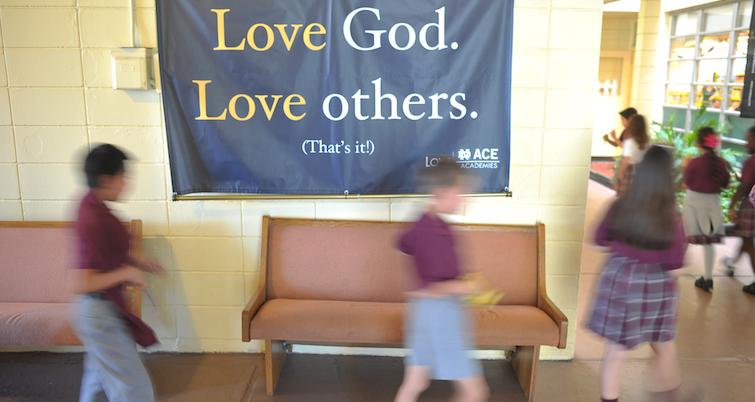Sitting on a dusty street corner just off of Interstate 10 in Tucson, Ariz., is Santa Cruz Catholic School, where students have taken to heart Jesus' command to love thy neighbor—neighbors who, for them, are often homeless.
According to the 2013 Homelessness in Arizona Annual Report, "the density of Pima County's homeless population remains the highest in the state and higher than the national average," with one of every 131 people having experienced homelessness. Many of these people live in South Tucson.
Fifth grade and ACE Teacher Rose Raderstorf said she spends the first few weeks of the school year at Santa Cruz discussing Catholic Social Teaching with her ten- and eleven-year-old students.
"My kids had never heard of it, but they quickly latched on to the ideas of respecting human dignity, preferential option for the poor, and solidarity," Raderstorf said.
The class worked to make these teachings relevant to their own lives. Raderstorf patiently listened as the children worked to find ways that they could truly show love for the poor, even as young people, even with limited resources. One student suggested making sandwiches for the people living in Santa Rita Park a few blocks down the street.
"He said, ‘we should make sandwiches for the people living in the homeless park. Then we should take it to them and eat with them so they have someone to talk to,'" Raderstorf said.
Santa Cruz is one of the Notre Dame ACE Academies in Tucson, a network of partner-schools with the University of Notre Dame's Alliance for Catholic Education that aim to provide a Catholic education of the highest quality to as many children as possible in under-served communities. Many Santa Cruz students benefit from the school's free and reduced lunch program, yet they worked together and made sacrifices to supply the materials needed to make the sandwiches.
"The first time we made sandwiches as a class, a few parents, students and I took them to the homeless park across the street after school," Raderstorf said. "We had so many left over that a parent suggested we take the extras to Casa Maria."
Casa Maria is a Catholic Worker Community which runs a soup kitchen and distributes over 500 lunches and 100 bags of groceries each day. In addition to providing nourishment, the Casa Maria community offers other services and ministries to the homeless community in South Tucson.
"While we were there, the director of Casa Maria told our class that they had run out of food that day and were not going to be able to give lunches to the 500-600 people that would be there the next afternoon. He told the kids that they were a God-send, and truly helping make miracles happen."
Inspired by their own ability to do good in the world, Raderstorf's fifth grade students now take sandwiches to Casa Maria each month. More than just feeding their neighbors, the fifth grade students are experiencing fellowship with those people so often overlooked or ignored by others.
"The last time we made sandwiches, we went to Mass with the Casa Maria community," Raderstorf said. "We sat on over-turned milk crates, right next to the people who would later be eating our sandwiches for lunch."
After Mass, one student wrote, "the best part of today was going to Mass with the people who were going to eat our sandwiches. They just smiled so big when they saw all the sandwiches. It was so cool that we did this, it gave me that butterfly feeling in my stomach."
In many schools, service becomes something out-of-the-ordinary: a field trip, a focused event during Catholic Schools Week, or a graduation requirement. For Raderstorf's fifth grade class, service is becoming a routine and a source of joy. They now hope to share that experience with others and are bringing more classes from Santa Cruz along to share the Eucharist and share their service with the homeless population of South Tucson.
In addition to material resources and academic programs, Notre Dame encourages each Notre Dame ACE Academy to develop a strong set of root beliefs and core values at the heart of each school's mission, which, for Santa Cruz, includes: "We are called to love because God loves us;" "We are called to be a family—sean una familia;" and "We are called to live the gospel." One signs that adorns the hallways and classrooms of Santa Cruz and the other Notre Dame ACE Academies reads: "Love God. Love others. That's it!"
Raderstorf's class shows that even those who have little to give can be incredible forces of good in the community and can show love and companionship to those so often abandoned or criticized. Their work is not complicated by motives or incentives. Instead, they are simply loving God by loving others.
"The church has it right," Raderstorf said. "We all need a little child-like faith."
 Alliance for Catholic Education
Alliance for Catholic Education
